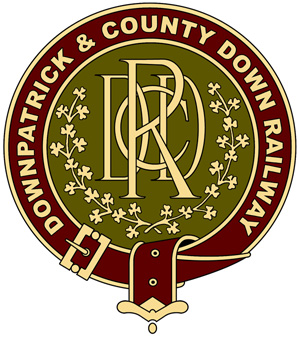| Downpatrick and County Down Railway | |||||||||||||||||||||||||||||||||||||||||||||||||||||||||||||||||||||||||||||||||||||||||||||||||||||||||||||||||||||||
|---|---|---|---|---|---|---|---|---|---|---|---|---|---|---|---|---|---|---|---|---|---|---|---|---|---|---|---|---|---|---|---|---|---|---|---|---|---|---|---|---|---|---|---|---|---|---|---|---|---|---|---|---|---|---|---|---|---|---|---|---|---|---|---|---|---|---|---|---|---|---|---|---|---|---|---|---|---|---|---|---|---|---|---|---|---|---|---|---|---|---|---|---|---|---|---|---|---|---|---|---|---|---|---|---|---|---|---|---|---|---|---|---|---|---|---|---|---|---|---|
 The DCDR logo, based on a monogram design used by the BCDR | |||||||||||||||||||||||||||||||||||||||||||||||||||||||||||||||||||||||||||||||||||||||||||||||||||||||||||||||||||||||
| Locale | Northern Ireland | ||||||||||||||||||||||||||||||||||||||||||||||||||||||||||||||||||||||||||||||||||||||||||||||||||||||||||||||||||||||
| Commercial operations | |||||||||||||||||||||||||||||||||||||||||||||||||||||||||||||||||||||||||||||||||||||||||||||||||||||||||||||||||||||||
| Name | Belfast and County Down Railway | ||||||||||||||||||||||||||||||||||||||||||||||||||||||||||||||||||||||||||||||||||||||||||||||||||||||||||||||||||||||
| Built by | Belfast and County Down Railway | ||||||||||||||||||||||||||||||||||||||||||||||||||||||||||||||||||||||||||||||||||||||||||||||||||||||||||||||||||||||
| Original gauge | 1,600 mm (5 ft 3 in) | ||||||||||||||||||||||||||||||||||||||||||||||||||||||||||||||||||||||||||||||||||||||||||||||||||||||||||||||||||||||
| Preserved operations | |||||||||||||||||||||||||||||||||||||||||||||||||||||||||||||||||||||||||||||||||||||||||||||||||||||||||||||||||||||||
| Operated by | The Downpatrick and County Down Railway Society Limited | ||||||||||||||||||||||||||||||||||||||||||||||||||||||||||||||||||||||||||||||||||||||||||||||||||||||||||||||||||||||
| Stations | 4 | ||||||||||||||||||||||||||||||||||||||||||||||||||||||||||||||||||||||||||||||||||||||||||||||||||||||||||||||||||||||
| Length | Approximately 3 miles (4.8 km) | ||||||||||||||||||||||||||||||||||||||||||||||||||||||||||||||||||||||||||||||||||||||||||||||||||||||||||||||||||||||
| Preserved gauge | 1,600 mm (5 ft 3 in) | ||||||||||||||||||||||||||||||||||||||||||||||||||||||||||||||||||||||||||||||||||||||||||||||||||||||||||||||||||||||
| Commercial history | |||||||||||||||||||||||||||||||||||||||||||||||||||||||||||||||||||||||||||||||||||||||||||||||||||||||||||||||||||||||
| Opened | 1859 | ||||||||||||||||||||||||||||||||||||||||||||||||||||||||||||||||||||||||||||||||||||||||||||||||||||||||||||||||||||||
| Closed | 1950 | ||||||||||||||||||||||||||||||||||||||||||||||||||||||||||||||||||||||||||||||||||||||||||||||||||||||||||||||||||||||
| Preservation history | |||||||||||||||||||||||||||||||||||||||||||||||||||||||||||||||||||||||||||||||||||||||||||||||||||||||||||||||||||||||
| Jan 1985 | Work started on building preserved railway | ||||||||||||||||||||||||||||||||||||||||||||||||||||||||||||||||||||||||||||||||||||||||||||||||||||||||||||||||||||||
| Dec 1987 | First public trains ran | ||||||||||||||||||||||||||||||||||||||||||||||||||||||||||||||||||||||||||||||||||||||||||||||||||||||||||||||||||||||
| Apr 1995 | South Line extended to Magnus' Grave | ||||||||||||||||||||||||||||||||||||||||||||||||||||||||||||||||||||||||||||||||||||||||||||||||||||||||||||||||||||||
| Sep 2005 | North Line extended to Inch Abbey | ||||||||||||||||||||||||||||||||||||||||||||||||||||||||||||||||||||||||||||||||||||||||||||||||||||||||||||||||||||||
| Sep 2014 | Carriage Gallery officially opened | ||||||||||||||||||||||||||||||||||||||||||||||||||||||||||||||||||||||||||||||||||||||||||||||||||||||||||||||||||||||
| Mar 2020 | Railway closes during COVID-19 pandemic | ||||||||||||||||||||||||||||||||||||||||||||||||||||||||||||||||||||||||||||||||||||||||||||||||||||||||||||||||||||||
| Jul 2022 | Railway reopens to public | ||||||||||||||||||||||||||||||||||||||||||||||||||||||||||||||||||||||||||||||||||||||||||||||||||||||||||||||||||||||
| Oct 2023 | Railway Temporarily Closes due to severe flooding and resulting damage | ||||||||||||||||||||||||||||||||||||||||||||||||||||||||||||||||||||||||||||||||||||||||||||||||||||||||||||||||||||||
| Oct 2024 | Railway reopens following flood damage | ||||||||||||||||||||||||||||||||||||||||||||||||||||||||||||||||||||||||||||||||||||||||||||||||||||||||||||||||||||||
| Website | |||||||||||||||||||||||||||||||||||||||||||||||||||||||||||||||||||||||||||||||||||||||||||||||||||||||||||||||||||||||
| downrail.co.uk | |||||||||||||||||||||||||||||||||||||||||||||||||||||||||||||||||||||||||||||||||||||||||||||||||||||||||||||||||||||||
| |||||||||||||||||||||||||||||||||||||||||||||||||||||||||||||||||||||||||||||||||||||||||||||||||||||||||||||||||||||||
The Downpatrick and County Down Railway (DCDR) is a 5 foot, 3 inch (1,600 mm) gauge heritage railway in County Down, Northern Ireland. It is operated by volunteers and runs passenger trains using steam and diesel locomotives, diesel railcars, and vintage carriages. [1] The railway has approximately three miles (4.8 km) of track in a triangular-shaped layout, which connects the town of Downpatrick with the historical sites of Inch Abbey to the north and King Magnus’ Grave to the south. [2] It also houses a museum of railway artefacts and rolling stock originating from both Northern Ireland and the Republic of Ireland, dating from the 1860s to the 1980s. [3] [4] [5]
Contents
- History
- Belfast and County Down Railway
- Decline and closure of the Belfast – Newcastle Line
- Heritage Railway
- Operations
- Stations & Buildings
- Stations
- Buildings & Structures
- Carriage Gallery
- Rolling Stock
- Overview
- Stock Lists
- Awards
- Television and film appearances
- See also
- References
- Further reading
- External links
The DCDR's development was spearheaded by a group of local railway enthusiasts in the early 1980s, and work started on building the railway in 1985. Most of its track is on part of the now-closed Belfast and County Down Railway (BCDR) mainline which ran between Belfast, Downpatrick, and Newcastle. The heritage railway first opened to the public in December 1987, and originally consisted of little more than a short stretch of track with an E-class diesel locomotive and a brake van. [6] It has expanded incrementally since then, and reached its current length with the completion of the Inch Abbey line in 2005.
The DCDR is the only five-foot, three-inch gauge heritage railway in Ireland, [7] which has been the standard gauge on the island since the 1840s. [8] With its Downpatrick terminus located at the foot of Down Cathedral and next to the Saint Patrick Centre, the railway has become a major tourist attraction for the town and has accumulated several hundred members. It currently has three steam and eight diesel locomotives, five of which are on loan from the Irish Traction Group, as well as the largest collection of Victorian railway carriages in Ireland. [9] Some of these have been overhauled by the railway's volunteers from a dilapidated state, and have received awards for their restoration. [10] [11]







































































